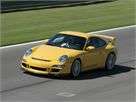Recent Articles
Popular Makes
Body Types
A Day in Paradise
For once we get to do what you think we always do
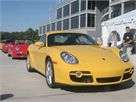
When you tell someone that you write about cars for a living, one of the inevitable questions that usually comes up in the conversation is something like: “Wow, cars huh? So you just spend all day driving Porsches around a racetrack or something?” Of course, we laugh this off, explaining that the vast majority of our time is spent in the office writing, answering e-mail and phone calls, and sleeping through meetings, just like every other job out there. Sure we drive cars, but we aren’t just blasting around race tracks in Porsches all day. That never happens.
Except, y’know, when it does.
Page 2
Birmingham, Ala., isn’t the first place to spring to mind when you think about Porsches on a race track. That is, until you learn that Barber Motorsports Park is home to the Porsche Driving Experience, a driving school all manner of Porsches are available on one of the most beautiful and scenic tracks in the U.S. This is where we were able to sample Porsches latest sports cars, with Porsche’s factory race drivers in the passenger seat. Our rides? The standard non-S Cayman, the Boxster S, the 911 Targa, the 911 Turbo and – be still our beating hearts – the 911 GT3.
How I wish I was in Dixie…

Page 3
With only 245 horsepower and 201 lb.-ft. of torque, the Cayman was the least powerful car of the group we drove. Not surprisingly, it also felt the slowest on Barber’s undulating pavement. The big difference here isn’t the horsepower, but the torque: with 50 lb.-ft. less at a higher peak than the 3.4-liter engine in the Boxster S, the Cayman’s little 2.7-liter felt a bit overtaxed, and we suggest opting for the six-speed manual so that you can stay in the meat of the torque band longer. If you’re looking for higher performance overall, the extra stretch to the Cayman S is definitely worth it.
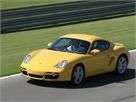
Page 4
The basic Cayman’s handling was impressive, even if it is clearly the entry-level Porsche. The car’s light weight (the lightest car on the track) translated into a tossable feel. The relatively low limits and neutral mid-engine handling meant that it was hard to get yourself in trouble, especially with the Porsche stability control engaged. This would be the ideal car for a budding Porschephile to buy and learn in. Hit those club events, wail it around the track, and learn what going fast is about. Then, when you’ve mastered it, move up to one of the bigger, faster cars.
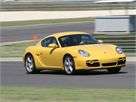
Page 5
Put an S in any Porsche’s name and you have instant power and handling upgrades. Based on the same basic platform as the Cayman, the difference between it and the Boxster S was surprising. Power is much improved, and the 295 horsepower and 251 lb.-ft. of torque are more than adequate for the track’s small up hills. Despite its commonality with the hardtop, the Boxster doesn’t drive like a convertible Cayman, but has its own distinct personality. The suspension differences were stark enough that the Boxster, despite a looser chassis thanks to being roofless, felt more rigid and responsive; were the asphalt less smooth on the track, chassis stiffness would have been a greater factor we’re sure.
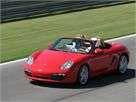
Page 6
Torque is the biggest difference here, which is interesting because the displacement increase is strictly due to bore size, which often sacrifices stroke for horsepower. Yet you notice the former here, with plenty of grunt to fire the Boxster up over Barber’s short uphill sections without complaint. It’s not as effortless as some of the other cars, but clearly the Boxster isn’t struggling like the Cayman was. Part of the difference is also undoubtedly the six-speed transmission, which boasts ratios better suited to taking advantage of the engine’s power and torque curves.
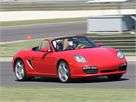
Page 7
The Targa 4 was the only mainstream 911 available for us to drive. Despite the addition of 60 horsepower over the Boxster, it somehow felt pudgy and less responsive than the smaller convertible. We blame the added weight: Between the larger body and the all-wheel drive system, the Targa weighs nearly 400 pounds more than the Boxster. Also, the innovative sliding glass targa roof – which adds 130 pounds over a regular 911 – puts a lot of that weight high in the air, consequently raising the Targa’s center of gravity. Still, the Targa is obviously more powerful and faster, and the bigger 3.6-liter engine produces a great deal more torque.
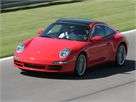
Page 8
The small hills at Barber posed no challenge for the Targa. You can feel the weight up high during quick transitional responses thanks to the big glass roof over your head, but most performance cars would do very well to mimic exactly how the Targa performs on the track. The all-wheel drive system plants the 325 horses aggressively, and the extra torque over the Boxster is noticeable as you power out of corners, thanks to both the maximum torque available and lower torque peak. It’s still a fun car and it feels faster than the Boxster in a straight line, but it may not be the ultimate driver’s Porsche.
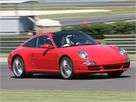
Page 9
The Turbo boasts a 155 horsepower advantage compared to the Targa, but weighs only an additional 100 pounds. The resulting acceleration is stunning. The car launches hard, with only the slightest hint of lag from the turbos, and it keeps accelerating hard all the way to redline with no flat spots. On Barber’s uphill Turn 3, the Turbo felt like it would launch itself into the infield; faith in gravity and Kees Nierop’s constant chatter of “the car can do it” kept my foot in the throttle.
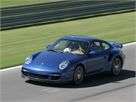
Page 10
The steering, brakes and suspension of the 911 Turbo make for a car that feels hard-wired to your brain. Responsiveness is amazing; the car goes without hesitation where you want it to. On Barber’s front straight the car rocketed forward, touching over 110 in the short distance before I was compelled to brake…too early, as there was plenty of room left before Turn 1. We recently had a 911 Turbo in our Irvine office, and I’ll admit that on the street it loses some of its charm; the suspension is exceptionally stiff on-road, and the lag is more noticeable in traffic. But on the track, there is only one Porsche that bests it.
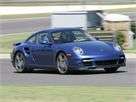
Page 11
Any car that can make the awesome 911 Turbo feel soft and mushy must be amazing in its own right. The 911 GT3 is that car, distilling the turbocharged 911’s driving experience to its fundamentals. Even on the glassy smooth pavement of Barber the GT3 felt stiff; I can only imagine what it would be like on the pounding freeways of Los Angeles. It has less power than the 911 Turbo (415 hp vs 480 in the Turbo), but it has 400 fewer pounds of car to haul around, giving it a roughly equal power-to-weight ratio; that means it’s just as quick and fast.
